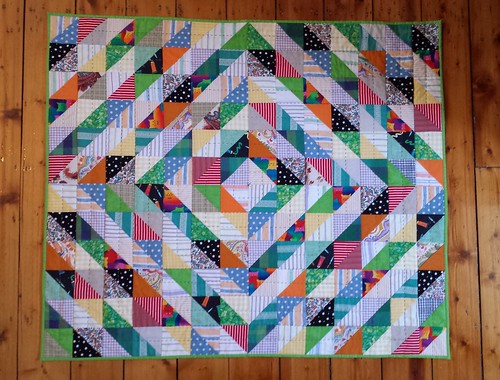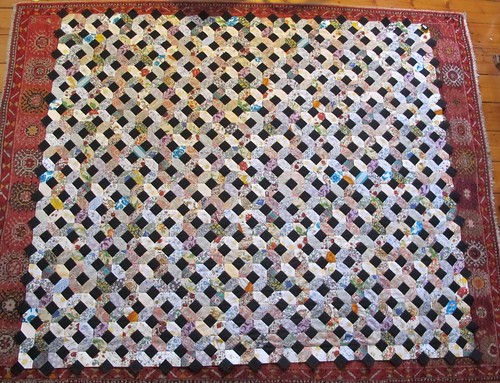
I had a small stack of under loved embroidered things. Garments, tablecloths, napkins, doilys, tea cloths, pillow cases, handkerchiefs etc. Some have already been turned into new garments but I kept any embroidered offcuts. I had been musing on the idea of making a patchwork quilt to use them up. We were in lockdown here due to Covid, not a bad time to embark on this.
I started in early July by settling on a block size driven by some of the larger motifs that I didn’t want to have to cut into. Anything smaller or awkwardly placed was built up to the right size using the plainer offcuts. I think that first round gave me about 50 pieces.
I have to share this cute puppy with you. The embroidery is not good but it was done by primary school me so it had to be included. There are so many memories in these embroidered bits. Quite a few were done by my grandmother, many by friend’s family. There are also pieces from childhood garments and my cot pillowcases sent over by Mama.

Eventually I came up with an overall design, which said I needed not just 50 pieces, but 144! So I put the call out to family and friends to make up the balance. This is partway through the collection. I think I still needed about 30 pieces.

Then in early September, the last donations came in, much of which was embroidery done by my friend’s family members. Lovely stuff to receive.

My plan was to checkerboard the embroidered bits with nine patches in nice strong colours, a pretty classic design. So I raided my hoarded cotton and linen offcuts, some of which are themselves embroidered.

Then shades of pale for the other “colour” of the ninepatches to blend with the background of most of the embroidered bits. I was in this stage developing a cunning plan for the arrangement of the dark pieces particularly. Way too much thought went into this and many, many rearrangements of the stacks.

Quite some intense time on “the zen of little bits of fabric” as I tend to dub this kind of repetetive construction and I had the needed ninepatches assembled.

A few more days of fun arranging and sewing got the patchwork done. Here it is all layered up ready to pin baste and showing nicely my cunning plan with the nine patches. The colours are arranged to give shades of red/purple on one diagonal and blue/green on the other. I had worried that it would be too hard to manage the orientation of the blocks to make this work but I did it with only a modest amount of unpickery. I’m really pleased with how this worked.


After it was basted, I was a bit over it so it rested for a couple of weeks until I could face the quilting. I was hoping that I could get that done before the weather got too warm to be sitting at least partly under a quilt for extended periods. To my pleased astonishment, it only took me 20 days! Ta dah!

Then another couple of days to do the binding, and now it’s a done thing, less than 4 months since I started. To clarify, it’s machine pieced, safety pin basted, and hand quilted. The binding is attached by machine and finished by hand. All rather quicker than the hand pieced Liberty Lattice quilt that took me a year for just the piecing.

Of course it has to have a label

and proving it fits on the bed.

All the materials were from some kind of stash, both mine and others, except a little of the sewing thread. The backing was from my mother who had been planning a quilt for many years but eventually decided she wasn’t going there. More power to her for releasing herself from that looming non-project. The batting was an opshop find, which I think might be bamboo, it’s a little too shiny to be cotton.
I’m so pleased with this. It’s light and bright and summery with so much interest and many memories to enjoy. The embroidery features so many things: flowers galore, butterflies, birds, deer, fleur-de-lis, cauldrons, shrimp, swordfish, people; a donkey, giraffe and a teacup. Also, all those under loved bits of embroidery have a new and useful life.


































